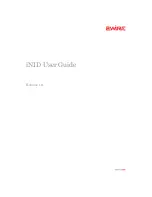
RC56D, RC336D, and RC144D Modem Device Sets Designer’s Guide
1154
Conexant
1-9
External Bus Interface
The non-multiplexed external bus supports eight bidirectional data lines (D0-D7) and 18 address output lines (A0-A17). Read
enable output (~READ), write enable output (~WRITE), and four chip select output (~ROMSEL, ~RAMSEL, ~DPSEL, and
~SCPSEL) lines are also supported.
The external bus connects to OEM-supplied 1Mbit (128k x 8) or 2Mbit (256k x 8) external ROM/flash ROM, 1Mbit (128k x 8)
or 32k x 8 external SRAM, the MDP, and the optional RCDSVD SCP depending upon modem model. The modem memory
options are shown in Table 1-2.
Table 1-2. Modem Memory Options
External Memory Required (Bytes)
Modem Model
ROM:
90 ns, 256k
ROM:
45 ns, 128k or 256k
ROM:
70 ns, 128k or 256k
RAM:
15 ns, 128k
RAM:
45 ns, 32k
RAM:
70 ns, 32k
RC56D
X
—
—
RC336D
X
X
—
RC144D
X
X
X
Telephone Line/Telephone Interface
For U.S. operation, the modem can operate with 1-relay data/fax/TAM DAA interface (Figure 1-3) or a 2-relay
data/fax/TAM/V.61/Speakerphone DAA interface (Figure 1-4).
Voice mode signal routing commands are summarized in Table 1-3.
MCU. Relay control outputs to the line interface are supported:
•
~RLY1: Off-hook (~OH)
•
~RLY2: Voice (~VOICE), if needed. Pulse (~PULSE) relay function can be enabled by ConfigurACE II.
•
~RLY3: Mute (~MUTE), if needed, can be enabled by ConfigurACE II.
•
~RLY4: Caller ID (~CALLID) if needed. The DAAs shown in Figure 1-3 and Figure 1-4 support the Caller ID function without
use of a separate relay.
Ring signal (RINGD) and loop current sense (LCS) inputs are supported.
MDP. A single-ended receive analog input (RIN) and a differential transmit analog output (TXA1/TXA2) are supported. A
digitized speaker output (SPKMD) is provided for call progress monitoring.
Speakerphone Interface (SP and SVD Models)
Microphone input (MICV) and a speaker output (SPKM) lines connect to handset, headset, or a microphone and speaker to
support functions such as AudioSpan headset and speakerphone modes, FDSP, telephone emulation, microphone voice
record, speaker voice playback, and call progress monitor. The speaker output (SPKM) carries the normal speakerphone
audio or reflects the received analog signals in the modem.
An input from the telephone microphone (TELIN) and an output to the telephone speaker (TELOUT) are supported in
AudioSpan modes. These lines connect voice record/playback and AudioSpan audio to the local handset.
RCDSVD SCP Interface (SVD Models)
The Line In (LINEIN) and Line Out (LINEOUT) lines connect DSVD audio to the local telephone handset.
Microphone input (MICIN) and speaker output (SPKP) lines connect to the microphone and speaker to support DSVD
headset and speakerphone modes.
Summary of Contents for RC144D
Page 87: ...INSIDE BACK COVER NOTES ...
















































